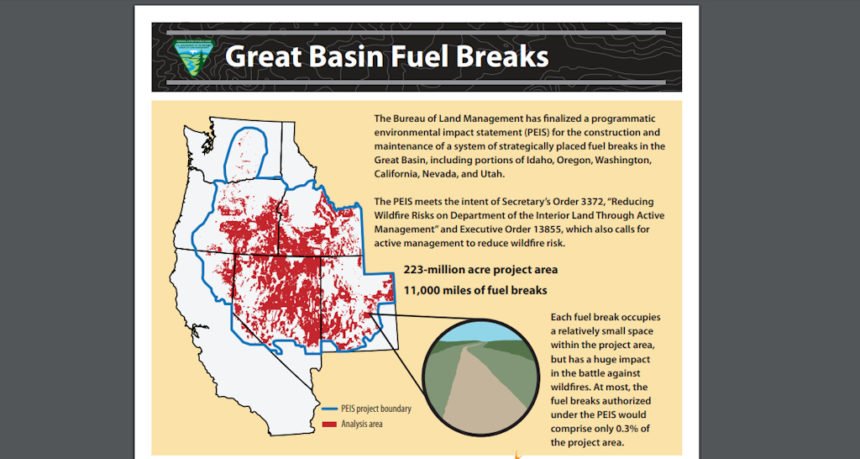Interior secretary OKs plans for 11,000 miles of fuel breaks across the West

Effort covers 223 million acres in Great Basin across six states
WASHINGTON (KTVZ) U.S. Secretary of the Interior David Bernhardt signed a final decision Wednesday to construct and maintain a system of up to 11,000 miles of strategically placed fuel breaks to control wildfires within a 223 million-acre area in parts of California, Idaho, Nevada, Oregon, Utah and Washington.
Local Bureau of Land Management district and field offices will use manual, chemical and mechanical treatments, including prescribed fire, seeding and targeted grazing, to construct fuel breaks along roads and rights-of-way on BLM-administered lands.
The fuel breaks will minimize new disturbance and wildlife habitat fragmentation and maximize accessibility for wildland firefighters, the agency said.
“This is a major step in fulfilling the president’s commitment to western communities by implementing more effective wildfire treatments that will better protect Americans, their property and their lands,” said Secretary Bernhardt.
The BLM said it has extensively documented that fuel breaks and other types of fuel treatments are effective. Since 2002, the agency has assessed more than 1,400 fuel breaks and other types of fuels treatments that intersect with wildfires and determined that 79% of fuel breaks are effective in helping to control wildfires and that 84% are effective in helping to change fire behavior.
Intact sagebrush communities are disappearing within the Great Basin due to increased large and severe wildfires, the spread of invasive annual grasses and the encroachment of pinyon-juniper.
The sagebrush communities in the Great Basin are home to over 350 species of plants and wildlife and are a vital part of western working landscapes. Approximately 45% of the historical range of sagebrush has been lost.
“Constructing a system of fuel breaks is a critical first step to reduce the risk of more catastrophic wildfires in the remaining intact sagebrush communities, but we can’t stop there,” said Deputy Director of Policy William Perry Pendley. “Fuel breaks will be most effective when combined with fuels reduction and rangeland restoration treatments and we’ll soon release a draft plan to provide for those in the Great Basin as well.”
Fuels reduction and rangeland restoration treatments can reduce fire severity, increase sagebrush communities’ resistance to invasive annual grasses and improve their ability to recover after wildfires. Wednesday’s Record of Decision for the Final Programmatic Environmental Impact Statement for Fuel Breaks in the Great Basin was based on public input through an open comment period.
The PEIS does not authorize any specific projects. Local BLM district and field offices within the Great Basin will use the PEISs to comply with National Environmental Policy Act requirements when planning and analyzing specific fuel break, fuels reduction and rangeland restoration projects to allow for more rapid implementation.
An electronic copy of the ROD, the Final PEIS for Fuel Breaks in the Great Basin and associated documents are available at https://go.usa.gov/xnQcG.